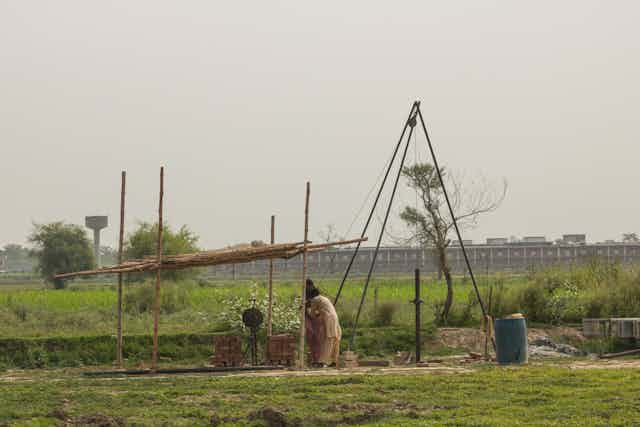More than 50m people in Pakistan are at risk of arsenic poisoning from contaminated groundwater. That’s according to a study recently published in the journal Science Advances, based on samples from 1,200 wells across the country. Arsenic cannot be removed from groundwater through common processes such as boiling or filtration – instead it requires expensive procedures such as reverse osmosis which are beyond the reach of most poor people.
Contamination is particularly worrying in this case as Pakistan is unusually dependant on a single, vast underground natural reservoir known as the Indus basin aquifer. The aquifer covers an area of 160,000km² – making it slightly larger than England – and spans Pakistan’s border with India.
Arsenic contamination may not even be the most alarming thing about the aquifer, however. At current rates of groundwater mining there is considerable risk the wells will eventually run dry.

Both Pakistan and India have historically subsidised electricity and diesel for running agricultural wells that tap into the aquifer. Groundwater users only pay for the energy used to mine the resource; the water itself is not metered or priced. The aquifer is literally free for anyone to tap into by drilling a well – whether it is for agricultural, industrial or domestic purposes.
Both countries are taking out far more water than is being replenished by rain or rivers. In fact, India extracts more groundwater than any other country in the world (not just from the Indus), and Pakistan is fourth in the list. The Indus aquifer is already the second most “overstressed” groundwater basin in the world and, at current rates of use, reserves like this may be “severely depleted” over the next few decades.
Where the water goes
More than 300m people live in the largely agricultural and extensively irrigated Indus basin. Of the total water used for irrigation about half comes from the aquifer below ground, rather than rainwater or the river itself and its various tributaries. There are irrigation canals, but their flow is concentrated in the summer monsoon period and isn’t as readily available as groundwater.

Despite increased concerns over groundwater use, governments on both sides of the border have been encouraging farmers to produce and export water-intensive food crops and livestock products. Given lots of water from a fast-diminishing aquifer is needed to produce everything from a grain of rice to a slab of beef, this trade amounts to “virtual water” exports. “Virtual water” refers to water embedded in trade products. A country that exports rice is in effect also exporting the water that is used to grow rice. This is why water-starved countries such as Saudia Arabia have stopped growing products like wheat. Importing food instead essentially means they “import” water rather than using their own scarce reserves.
Key exports from India and Pakistan including rice, sugar, cotton and textiles all require lots of water to produce. In addition, both governments are incentivising the growth of meat exports through the use of various subsidies, without considering the water footprint. Pakistan’s halal meat export trade has grown more than ten-fold in the past decade, for instance – mainly to water-scarce countries such as Saudi Arabia.

Growing development pressures and increasing industrialisation in India and Pakistan also contribute to increased groundwater stress and pollution. Though official estimates say industry uses a mere 2% of the groundwater extracted in India, and even less in Pakistan, the reality is likely to be much more. In the Indus region, the aquifer is crucial for water-intensive sectors such as textiles or leather and, in practice, industrial mining of the region’s groundwater is not metered or priced. Most industrial units also discharge untreated effluents in unlined pits, which eventually seep into the ground and has resulted in severe contamination of the water table.
A finite resource
In India, some states where groundwater levels are critical now require a license to drill new wells. In Pakistan, however, unlicensed drilling continues. The current legal framework for groundwater is spread across a variety of instruments both from colonial and post-colonial times, as well as local customs that often conflict with each other. Property rights are largely defined by an archaic piece of colonial legislation, the Easements Act of 1882, which allows landowners to effectively collect and dispose of underground water as long as it is not a part of a public irrigation network.
Most of the elaborate state irrigation bureaucracy serves to manage and distribute surface water – not the aquifer. India has recently established a Central Groundwater Board, but in Pakistan monitoring and management still happens in silos, with no particular institution taking responsibility for the conservation of the resource.

